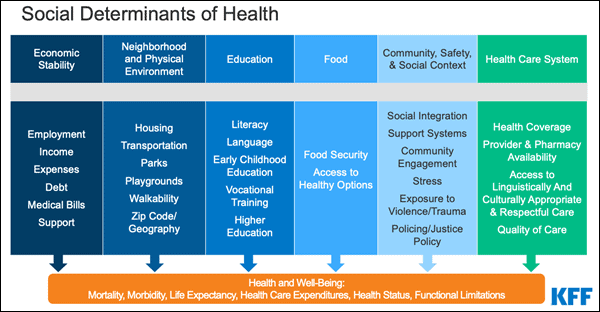Healthcare at Home Blog Series: Exploring Social Determinants of Health
Entering Consumer’s Home Provides Unique Look at SDoH
THE VBP Blog

Throughout our Healthcare at Home blog series, we’ve looked at a variety of topics, including the shifting policy landscape to support healthcare at home, innovative technology accelerating the trend, and major players investing in the space.
While shifting healthcare delivery to the home offers many benefits to both consumers and providers, one of the biggest is that it gives providers more insight into the lives of consumers. This in-depth look allows providers to assess different social determinants of health (SDoH) and how they may be impacting health. Without this visibility, healthcare providers only see the physical health indicators and they are not able to address SDoH and provide whole-person care.
What Are Social Determinants of Health?
Social determinants of health are conditions in the places where people reside, work, and learn that affect a variety of health and quality-of-life risks and outcomes. More specifically, the World Health Organization (WHO), defines social determinants of health as, “the conditions in which people are born, grow, work, live, and age, and the wider set of forces and systems shaping the conditions of daily life.” These non-medical factors and forces shape the conditions of daily life and influence health inequities.
According to Health.gov and the CDC, SDoH can be grouped into 5 domains. As shown below, these domains are Education Access and Quality, Health Care Access and Quality, Neighborhood and Built Environment, Social and Community Context, and Economic Stability.

Source: Centers for Disease Control and Prevention
The Sixth SoDH: Food
Though social determinants of health are grouped into 5 categories by many, as shown below, others add a sixth category – food. This category doesn’t just include food security, but also access to healthy options as poor nutrition can lead to poorer health outcomes.

Source: Kaiser Family Foundation
It is important to be aware that while experienced by individual consumers, SDoH exist at the community level. Aspects like demographics, community safety, education, physical infrastructure, and quality of healthcare facilities are experienced by the community as a whole. However, while the community shares exposure to SDoH, the Agency for Healthcare Research and Quality (AHRQ) notes that individuals have varying social needs that impact them.
While one member of a community might be homeless, another has adequate housing. While one member is employed with a well-paying job, another might be unemployed or underemployed. The same goes for food insecurity, communication barriers, educational barriers, and more. The healthcare system must address both community-level SDoH, as well as the individual social needs of consumers. This is no small feat, which is why AHRQ released SDoH Practice Improvement tools that are designed to help healthcare organizations address social determinants of health.
The Importance of Social Determinants of Health
There has been a big emphasis placed on social determinants of health in recent years and you might be wondering why they are so important. Research shows that they can be just as important or more important than healthcare or lifestyle choices in influencing one’s health.
Many studies estimate that SDoH account for somewhere between 30% and 55% of health outcomes. These studies are not denying that medical care influences health, rather emphasizing that medical care is not the only influence on health. These studies also indicate that medical care may be more limited than previously thought, especially when it comes to determining who becomes injured or sick in the first place.
As shown in the chart below, only 20% of health outcomes can be explained by access to and quality of healthcare, while another 30% can be explained by health behaviors. Half is attributable to socioeconomic factors like education, employment, and family support, and an individual’s physical environment like their home or lack thereof.

Source: Alliance for Strong Families and Communities
This is important to understand as this is not just a healthcare system problem. An overwhelming percent of health outcomes are attributed to factors that are not necessarily addressed by the healthcare system, rather by human services organizations.
So, if they are so important why aren’t social determinants of health incorporated into every care plan? The issue is that addressing SDoH can be difficult as providers do not often have access to this information when providing care. However, shifting healthcare delivery to the home is beginning to change that as it provides more insight into the lives of consumers, from the community they live in to their health behaviors like diet and alcohol consumption.
Advocate’s Perspective
Social determinants of health are being taken more seriously when it comes to healthcare and health outcomes. There is no better time for this focus than now when healthcare is shifting into the home as it provides a more in-depth look the lifestyles and behaviors that impact consumers’ health. However, as this shift occurs, it is important to understand that changes need to come at both the community and individual levels. In addition, healthcare providers and human services organizations need to collaborate and work together to address social determinants of health to improve overall health comes. By doing this, SDoH can be assessed and incorporated into care plans that focus on the whole-person and involve all parties necessary to achieve success.
Our next blog will take a deeper look into how healthcare at home programs are allowing providers to assess and incorporate social determinants of health into whole-person care plans.
Onward!
Share This Blog!
Get even more insights on Linkedin & Twitter

About the Author
Fady Sahhar brings over 30 years of senior management experience working with major multinational companies including Sara Lee, Mobil Oil, Tenneco Packaging, Pactiv, Progressive Insurance, Transitions Optical, PPG Industries and Essilor (France).
His corporate responsibilities included new product development, strategic planning, marketing management, and global sales. He has developed a number of global communications networks, launched products in over 45 countries, and managed a number of branded patented products.

About the Co-Author
Mandy Sahhar provides experience in digital marketing, event management, and business development. Her background has allowed her to get in on the ground floor of marketing efforts including website design, content marketing, and trade show planning. Through her modern approach, she focuses on bringing businesses into the new digital age of marketing through unique approaches and focused content creation. With a passion for communications, she can bring a fresh perspective to an ever-changing industry. Mandy has an MBA with a marketing concentration from Canisius College.